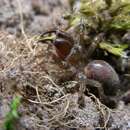en
names in breadcrumbs


The mygalomorph spider family Atypidae (purseweb spiders) includes 49 species in 3 genera (Platkin 2013). Purseweb spiders are found in the Holarctic (Nearctic + Palearctic regions) as well as in the Old World tropics. In North America north of Mexico, purseweb spiders are found only in the eastern half of the United States and in southern Ontario, Canada. Eight species occur in this region, seven of them in the genus Sphodros and one in Atypus. (Coyle 2005)
Purseweb spiders buld a silken tube that is partly buried but extends above the ground. The exposed part of the tube is often attached to a tree trunk, rock, or other vertical surface. The surface of the tube is covered with bits of debris and soil, helping it blend in with its surroundings. The spider waits within the tube and when it senses vibrations from potential prey walking over the tube, the spider strikes through the tube wall with its very long fangs. After capture, a small temporary slit is cut in the tube and the prey is drawn in, after which the slit is quickly repaired. The spider thus lives almost its entire life hidden from view—and some females have been known to live for at least seven years. Only dispersing juveniles and adult males in search of mates are found out in the open.(Coyle 2005; Bradley 2013)
A striking morphological feature of purseweb spiders is their large, forward-projecting chelicerae. These are often two thirds as long as the carapace (the upper surface of the cephalothorax) and armed with long, heavy fangs. Although these large-fanged spiders appear quite fierce, especially when they rear up in a defensive posture, they are harmless to humans and will not bite unless provoked.(Bradley 2013)
More information on purseweb spiders can be found in Gertsch and Platnick (1980) and Coyle and Shear (1981).